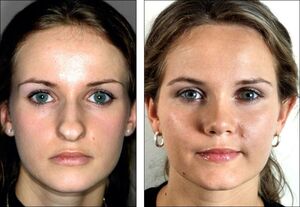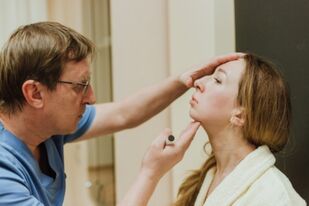Many people have heard of classical surgery, but non-surgical rhinoplasty is a relatively new method in medicine, and naturally there are many questions about it. This article will tell you about the nuances of conducting and restoring non-surgical rhinoplasty, which will be especially useful for people who live with complexes associated with nasal defects, but are not ready for surgery.
What is it and how is it done?
It consists of the installation of special fillers or threads in which the shape of the nose is corrected and symmetrical with the help of non-surgical correction of defects.
This method is suitable for those with respiratory problems and small defects that are not accompanied by a deviation septum or nasal bone.
This method can not be called a full-fledged alternative to surgery (except for laser rhinoplasty), because some defects can be corrected only with classical rhinoplasty.

The differences between non-surgical and classical rhinoplasty are as follows:
- there is no simplicity, long and painful rehabilitation period in the procedure (here we explained how rehabilitation takes place with traditional rhinoplasty);
- execution speed;
- affordable cost;
- short duration of effect;
- Failure to solve serious problems.
It should be noted that thisprocedure can be performed when the effect is weakened.
Types of plastic without surgery
Non-surgical rhinoplasty can take many forms. How each is done and how long the result will last will be explained in detail below.
Injection
Filler nasal plastic - a drug for injection used as a filler to correct defects caused by tissue deficiency. Theprocedure does not cause side effects,does not cause swelling and resolves on its own within 1. 5 years.
The nasal area is treated with antiseptic and then a filler is injected under the skin. The whole procedure takes about half an hour, after which the patient can go home.
Fillers can be:
- biodegradable- bio-substances - hyaluronic acid, produced on the basis of collagen;
- biodegradable- synthetic substances - silicone, etc.
- autologous- the body's own adipose tissue.
Injection rhinoplasty is also a hormonal medication. This procedure requires extreme care and precision, because if the exact dose is not followed, the situation may worsen.The effect after the procedure is very long,only complications in the form of tissue atrophy can occur.
Laser
In this case, a laser is used instead of a scalpel for plastic surgery on the nose, so the cuts become softer and the bleeding due to the rupture of the veins is eliminated.
The surgical approach to laser surgery is not much different from classical rhinoplasty.
With the help of a laser, the surgeon's task is simplified, it is possible not only to speed up the operation itself, but also to shorten the rehabilitation period. Prior to surgery, the patient should be prepared, tested and consulted with narrow specialists. Properly performed laser rhinoplasty protects the result for a long time.
Topics
Many plastic surgeons do not consider this type of rhinoplasty effective, so it is not common. Threads are often used to correct the shape of the nasal rope or wings (read about conventional rhinoplasty of the nasal wings, its tip and other parts). The specialist makes small holes where the ropes enter. Leather and fabrics are made of artificial material. The effect lasts a long time.
Langettes
Langette is a special device that looks like a plastic clothespin. It is designed to be worn for several hours a day, so it is possible to achieve changes in the shape of cartilage tissue. But it will take several months to learn the obvious effects. You can fix minor flaws:
- return the symmetry to the nose;
- make a small drum;
- lift the tip of the nose (you will learn how to solve problems with the tip of the nose using classic rhinoplasty from a special material);
- Reduce the width of the wings.
Before and after photos
Next, we suggest you get acquainted with the pictures of patients taken before and after nose plastic surgery without surgery.

Readings
Injection rhinoplasty is performed in the following cases:
- on the back of the nose;
- straight top back;
- nasal asymmetry;
- dips and valleys;
- swinging nose tip;
- sharp angles of the nose;
- needs correction after surgical rhinoplasty.
Indications for laser rhinoplasty are:
- change the length of the nose;
- the bridge of the nose is very wide;
- non-aesthetic nasal dorsum;
- wide or narrow end;
- nostrils too wide or too narrow;
- wing straightening.
There are functional indicators for this procedure:
- Damage to the nose with a bone or cartilage fracture;
- Congenital curvature of the nasal dorsum, which worsens air flow;
- cartilage base defect.
Contraindications
Some contraindications:
- presence of oncological disease;
- Predisposition to allergic reactions - a possible allergy to fillings injected under the skin;
- pregnancy and lactation;
- early childhood - cartilage tissue in children is not fully formed, and premature correction can lead to worsening of the condition in the future;
- Procedures are not recommended during menstruation.
Why is this technique dangerous?
Although non-surgical rhinoplasty has a very low impact on the condition of the body as a whole, it can lead to undesirable consequences:
- Improper insertion of the filler under the skin can cause the helium lumps to move sideways over time and will change shape as a result.
- There is a risk of infection and infection.
- Swelling and bruising appear immediately after the procedure, but in most cases these results disappear without treatment within a few days.
- It is not possible to change the shape of the nose immediately after a failed procedure, because the drugs used are persistent and their breakdown begins only after a few months.
Other complications include:
- pain;
- redness of the skin;
- embolic changes in blood vessels;
- fibrotic changes at the injection site;
- allergy;
- whitish deposits in adjacent injection zones.
Complications can be short-term or long-term, and if there is a persistent impairment in appearance or well-being, you should consult a specialist.
In most cases, various complications after non-surgical rhinoplasty occur when the procedure is performed by a low-skilled doctor or in non-specialized salons.
To protect yourself from such inactive events, you should be responsible in choosing a clinic and a doctor who will manage the procedure, and if necessary, properly prepare for the procedure. In addition, it is necessary to inform the doctor in advance about existing diseases, including chronic diseases, as the choice of technique will depend on it.
Here we talked about the results that patients can expect after classic rhinoplasty and how to avoid them.
Rehabilitation

Non-surgical rhinoplasty is characterized by a short rehabilitation period. On average, it will take 1-2 days for all caries and caries to disappear. Tissue swelling can last up to 5 days, and for faster reduction, it is recommended to apply ice compresses to the affected area in the first hours after the procedure - this will prevent the spread of edema.
Summary Table
| retinoplasty type | Pros | Conszz |
| Fillers |
|
|
| Hormonal Injections |
|
|
| Laser |
|
|
| Topics |
|
|
| Langette |
|
|
Dissatisfaction with one's appearance often leads to a person's complexity, the development of depression and psychosis. But sometimes just pulling the tip of your nose a little is enough to make life shine brightly and give you confidence.
However, not all those who are very dissatisfied with their appearance can get a classic rhinoplasty - some are afraid of the price, some are afraid of complications and unsuccessful operations, some are afraid of long-term rehabilitation. Although there is no full-fledged alternative to surgery in this situation, it makes sense to think about non-surgical rhinoplasty, which can easily overcome some of the shortcomings.




















